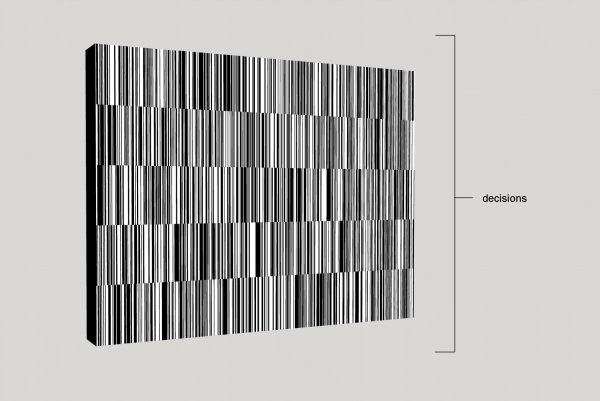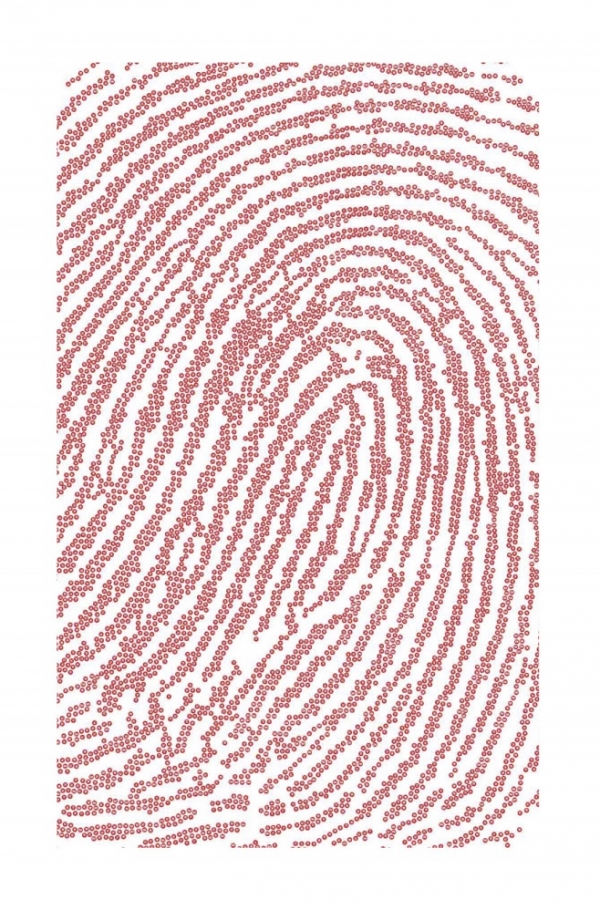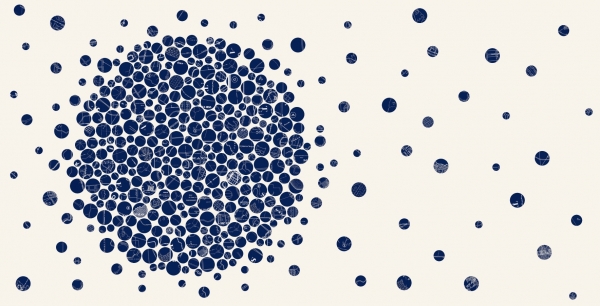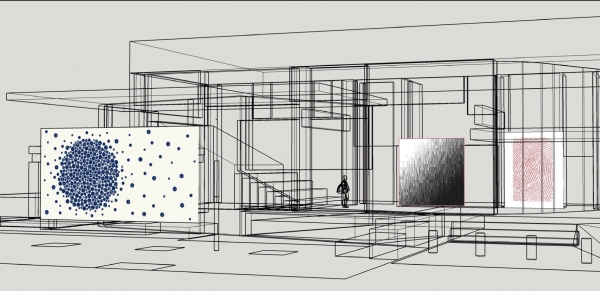Before Peter Wegner developed his art concept for Palo Alto's new public-safety building, he decided to see the world through the eyes of an emergency responder.
Wegner, an El Cerrito-based artist whose abstract pieces often contemplate the relationship between space and time, joined a police officer for a ride-along. At a routine traffic stop, he was struck by the speed and multitude of decisions the officer had to make: Should that person who slowed down but didn't fully stop at the stop sign be pulled over? Did the violation merit a ticket or a warning? What would be the best way to approach the driver? What the most appropriate response to what the driver says?
"At each juncture, there is a binary decision that has to be made," Wegner told the Weekly. "It felt like any moment involved a judgment call. In the aggregate, I can see the situation was in flux. With anything more complicated than a traffic stop, I can just see how very quickly you have to think through the split-second decisions — a blizzard of them."
This frenetic pace of making these judgment calls is reflected in "100,000 Decisions," one of three works in the suite of pieces that the City Council last week approved for the long-awaited public-safety building, a $115-million project that has been the city's top infrastructure priority for nearly two decades. Construction of the three-story structure at 250 Sherman Ave. is set to begin as soon as the city finishes building a new parking garage on an adjacent parcel, 350 Sherman Ave.
"100,000 Decisions" is a compilation of vertical black and white strips assembled within a square red frame. Up close, you can see thousands of bars made of ABS plastic, the material used to make police helmets and vests. Stepping back from the piece, the bars turn into a gradient, with gray on the inside dissolving into white in the top right corner and solidifying into black in the bottom left corner.
Wegner also recalled his ride with local firefighters to a medical call at a home where there had been a family tragedy, to which the department also had been called. Wegner said the firefighters' response was conditioned by prior knowledge of the trauma.
"It was a really nuanced and supple and beautifully gauged quality of response, and at the same time, there was a way of thinking that was strictly a current of ones and zeroes," he said. "That sat with me a bit. It started to feel like they entered into the middle of the frame where most of the values were gray or hard to describe at the moment and what was required of them was a quick, reflexive, intuitive decision-making where the pattern was only revealed at a distance."
This interplay of order and chaos also features prominently in "Chance Impression," a work of art inspired by Wegner's experience getting his fingerprints taken by the Police Department's forensics unit. Fingerprinting, Wegner discovered, is considered the first forensic discipline. When it was developed a century ago, it was referred to as "lifting of chance impression."
Both the name and the method are integrated into the piece, which consists of thousands of red thumbtacks impressed on the wall, creating the shape of a giant fingerprint. The piece intends to both represent the "hands-on" work performed in the building and the intersection between the rational scientific method used by officers and the unique, idiosyncratic nature of each human.
"I liked that there was a kind of analytical, rational framework for the forensic discipline," Wegner said. "You come across a crime scene that's just the aftermath of mayhem and you impose this rational, analytic, empirical process on the chaos that you encounter and you extract this information that hopefully allows you to encounter a criminal."
For Wegner, whose work is featured in world-famous museums such as the Guggenheim Museum in New York City, the San Francisco Museum of Modern Art and the Los Angeles County Museum of Art, the public-safety-building presented a different type of challenge. It required collaboration with and buy-in from a diverse set of stakeholders, including emergency responders, members of the Public Art Commission (which unanimously approved his concepts last December) and California Avenue merchants.
He was one of 63 artists who submitted their qualifications for consideration. The selection panel that chose him included — among others — interim Fire Chief Geoffrey Blackshire, architect Mallory Cusenbery, Assistant Police Chief Patty Lum, former city Mayor Yoriko Kishimoto and Michael Ekwall, owner of La Bodeguita del Medio, a restaurant on California Avenue.
Wegner also said he was mindful of the fact that, given the public nature of the new building, the set of stakeholders also includes "every taxpayer in Palo Alto." At the same time, Wegner made an effort to link the art in the new building with the more immediate setting: the California Avenue area that today is considered Palo Alto's "second downtown" and that once formed the heart of Mayfield. (Palo Alto annexed the city of Mayfield in 1925.)
The sense of place is at the heart of "Street Level," the third exhibit in Wegner's suite. The piece is comprised of about 400 aluminum disks, each featuring imagery from historical, hand-drawn maps of historic Mayfield and Palo Alto. The blue disks vary in scale — ranging from 3.5 inches to 7.5 inches in diameter. Wegner discovered the maps while going through local archives and talking to area historians.
The maps, Wegner noted, are in themselves "public art projects," — attempts to reconstitute the objects on the street landscape within the intellectual model that is a map. They are drawings created by the culture, even if the maker is usually anonymous. This, Wegner said, makes them "historically rich in meaning."
Fittingly, "Street Level" will be displayed on the building's exterior wall, adjacent to Jacaranda Lane and facing Birch Street. From a distance, a visitor won't necessarily see all the finely engraved line work, but they would at least see the "galaxy" of locations, he said.
"But because you can get closer as a viewer, I wanted to get a fair amount of detail so that close inspection is rewarded."
In another nod to the building's location, Wegner proposed a fourth piece, "94306," an LED display that would mimic the form of California Avenue structures, as seen from a bird's eye view. The piece, which referenced both Palo Alto's tech presence and California Avenue's eclectic nature, aims to create a "snapshot in time" of California Avenue as it is today, while also allowing for various and slowly-changing color displays based on time of day, the season and specific occasions.
That component, however, was left out of the final package that the council approved. While Wegner said he was "surprised" by the omission, he added that he is happy to see three of his artworks get included in the new structure.
Kristen O'Kane, director of the Community Services Department, said the LED piece was intended to be part of the California Avenue garage project, which went through a different art selection process. The city's procurement laws, she said, prohibited the city from adding "94306" to the police building project. Incidentally, the garage itself will not have a public art piece, O'Kane said. That's because the various façade enhancements in the garage, including decorative louvers and reflective tiles, limit the opportunity for art to be integrated there.
The city expects to finish constructing the new public-safety building by fall 2022, according to the city's recently approved capital budget. But the art is already causing some debate. Mark Weiss, an advocate for public art, criticized the city for cutting "94306" out of Wegner's suite and noted that given the police building's escalating price tag, the $716,000 contract with Wegner falls below the city's "1% for public art" threshold.
Councilman Greg Tanaka, on the other hand, argued that the budget is too high and voted against the contract. Tanaka cited other community needs, including housing and an improved animal shelter, that should be funded. He was the only dissenter, however, in the 6-1 vote to approve the contract.
Wegner said he plans to start working on the art projects within weeks. He said the experience of developing the concepts for the new building underscored for him the importance of engaging in a public dialogue. He hopes the art itself will have the same effect.
"These are works for the public square and I very much hope that the community will feel ownership of them and feel they are a natural complement," Wegner said.






Comments
Registered user
Downtown North
on Jun 27, 2019 at 9:53 pm
Registered user
on Jun 27, 2019 at 9:53 pm
My point is that for that kind of money we should get all four pieces of Wegner’s proposal. Staff, which went through a lot of turnover during this time frame, has not adequately explained the deletion.
Tanaka, besides misrepresenting the extent of the opposition, fixates on the thousands of dollars difference between the various ways to calculate “one percent” but shrugs off the much bigger question of the fifty MILLION dollar cost overrun for building as a whole. He’s a pander bear in fiscal hawk headress, best friend, apparently, to anybody with a cement mixer.
Another Palo Alto neighborhood
on Jun 28, 2019 at 1:47 am
on Jun 28, 2019 at 1:47 am
I saw some photos of the artwork and they are awesome. Law enforcement deserves a nice environment for the unselfish jobs they hold. Who wants to be a police officer or 911 operator? Most people cannot stomach such work. The current police station is atrocious, I’ve seen the interior working conditions. And it’s insane that a new building has been promised for decades yet still won’t be completed for 3 years. We always know that help is a phone call away. I say throw more money at the project; what is more important than our safety and health? Tanaka is misinformed; there is plenty of wasted money in our city, this is not a waste.
Downtown North
on Jun 28, 2019 at 11:42 am
on Jun 28, 2019 at 11:42 am
While I support public art, the price tag on this is exorbitant. What has happened is clear... a 1% metric for art (which is well-meaning and taken alone reasonable) is still being applied even when the cost of property and building has gone insane.
Clearest by example: This would be equivalent to a local family, newly buying a $2mil home in Palo Alto (doesn't get you much!), were to say, "Hey, we need to buy a $20,000 painting... that's not at all excessive, it's a reasonable art budget ratio!"
We need adults on duty. Make things beautiful (including art!) with some awareness of cost and common sense.
Midtown
on Jun 28, 2019 at 1:52 pm
on Jun 28, 2019 at 1:52 pm
Does anyone take into consideration how dated these pieces will be in a couple of years? How much we will have to pay to have the pieces maintained/restored and what will be spent in 5 years to replace the art with something cheaper?
Why don't we spend $100K for the initial artwork and then plan on spending $100K every 5 years to update the building with new art.
It is short sited to think that art is a one time purchase.
/marc
Green Acres
on Jun 28, 2019 at 2:29 pm
on Jun 28, 2019 at 2:29 pm
I love art and support local artists with my own money, but it is just wrong to spend tax dollars on something so extravagant. Why not spend less on a newer less well known artist that will probably be just as good?
Registered user
Downtown North
on Jun 29, 2019 at 11:10 am
Registered user
on Jun 29, 2019 at 11:10 am
Maybe next time a “newer less well known artist” will apply and be selected, over the 63 other applicants including Wegner.
Maybe you should apply for PAPAC.
Registered user
Downtown North
on Jun 29, 2019 at 11:12 am
Registered user
on Jun 29, 2019 at 11:12 am
Maybe next time a “newer less well known artist” will apply and be selected, over the 63 other applicants including Wegner.
Maybe you should apply for PAPAC.
The other thing we have to worry about, with the Wegner piece, is if a perp grabs one of the 49,000 pushpins and uses it as a weapon.
Another Palo Alto neighborhood
on Jun 29, 2019 at 3:01 pm
on Jun 29, 2019 at 3:01 pm
I just want the building to be survivable, and, operating after a big disaster. It should survive (protect the occupants) a magnitude 9.5 quake (Chile 1960-- Alaska 1964 was 9.2), and ride through undamaged with an 8.3 quake (estimated likely max for the next "big one" on the San Andreas fault.
Architects tend to dislike these requirements because the resulting buildings tend to be aesthetically uninteresting. Public safety buildings need to be operational during disasters.
Meadow Park
on Jun 29, 2019 at 8:41 pm
on Jun 29, 2019 at 8:41 pm
We have only 1.5 traffic enforcement personnel and only a couple of community officers, and the city is going to spend over $700,000 on artwork??? That is INSANE! I am very much against this needless spending and will remember this come election time.
Registered user
Leland Manor/Garland Drive
on Jul 1, 2019 at 11:08 am
Registered user
on Jul 1, 2019 at 11:08 am
@Anon - the rules about the survivability of police stations, fire stations and other public safety buildings are not in the purview of the architect. The codes are very strict and clear on the subject. I don't know what makes you think that it makes a building aesthetically uninteresting.
another community
on Jul 2, 2019 at 10:36 am
on Jul 2, 2019 at 10:36 am
As a former disaster manager -- AND an artist -- I find Wegner's art appropriate, very thoughtful, and impressive.
Old Palo Alto
on Jul 4, 2019 at 6:10 pm
on Jul 4, 2019 at 6:10 pm
Reminds me of the junk on California avenue median, the woman holding up the washing machine, the bizarre circuit board egg outside of the Pizza shop and the absolutely bizarre project to photograph every house in PA to find the Palo Alto color - all, publicly funded, wasted dollars and opportunities.
The money is pure waste and a violation of the city’s obligation to ensure that taxpayer money is spent responsibly.
Just paint some large, colorful squiggles, dashes, dots, and blotches on the walls and save the big bucks for the pot hole fund.